fuel filter FIAT TALENTO 2020 Owner handbook (in English)
[x] Cancel search | Manufacturer: FIAT, Model Year: 2020, Model line: TALENTO, Model: FIAT TALENTO 2020Pages: 236, PDF Size: 4.86 MB
Page 35 of 236
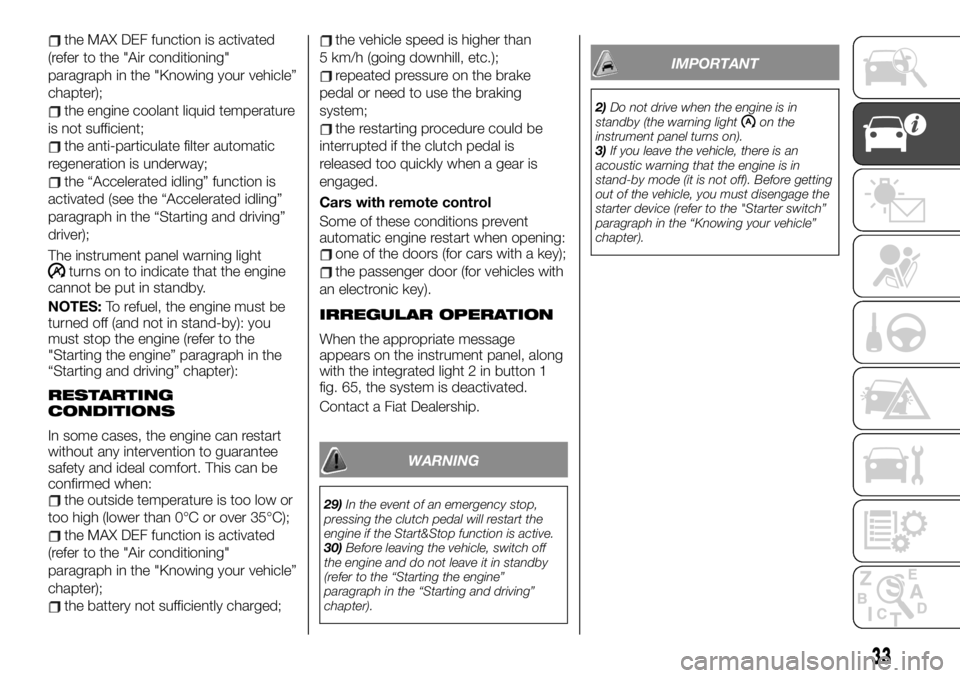
the MAX DEF function is activated
(refer to the "Air conditioning"
paragraph in the "Knowing your vehicle”
chapter);
the engine coolant liquid temperature
is not sufficient;
the anti-particulate filter automatic
regeneration is underway;
the “Accelerated idling” function is
activated (see the “Accelerated idling”
paragraph in the “Starting and driving”
driver);
The instrument panel warning light
turns on to indicate that the engine
cannot be put in standby.
NOTES:To refuel, the engine must be
turned off (and not in stand-by): you
must stop the engine (refer to the
"Starting the engine” paragraph in the
“Starting and driving” chapter):
RESTARTING
CONDITIONS
In some cases, the engine can restart
without any intervention to guarantee
safety and ideal comfort. This can be
confirmed when:
the outside temperature is too low or
too high (lower than 0°C or over 35°C);
the MAX DEF function is activated
(refer to the "Air conditioning"
paragraph in the "Knowing your vehicle”
chapter);
the battery not sufficiently charged;
the vehicle speed is higher than
5 km/h (going downhill, etc.);
repeated pressure on the brake
pedal or need to use the braking
system;
the restarting procedure could be
interrupted if the clutch pedal is
released too quickly when a gear is
engaged.
Cars with remote control
Some of these conditions prevent
automatic engine restart when opening:
one of the doors (for cars with a key);
the passenger door (for vehicles with
an electronic key).
IRREGULAR OPERATION
When the appropriate message
appears on the instrument panel, along
with the integrated light 2 in button 1
fig. 65, the system is deactivated.
Contact a Fiat Dealership.
WARNING
29)In the event of an emergency stop,
pressing the clutch pedal will restart the
engine if the Start&Stop function is active.
30)Before leaving the vehicle, switch off
the engine and do not leave it in standby
(refer to the “Starting the engine”
paragraph in the “Starting and driving”
chapter).
IMPORTANT
2)Do not drive when the engine is in
standby (the warning lighton the
instrument panel turns on).
3)If you leave the vehicle, there is an
acoustic warning that the engine is in
stand-by mode (it is not off). Before getting
out of the vehicle, you must disengage the
starter device (refer to the "Starter switch”
paragraph in the “Knowing your vehicle”
chapter).
33
Page 48 of 236
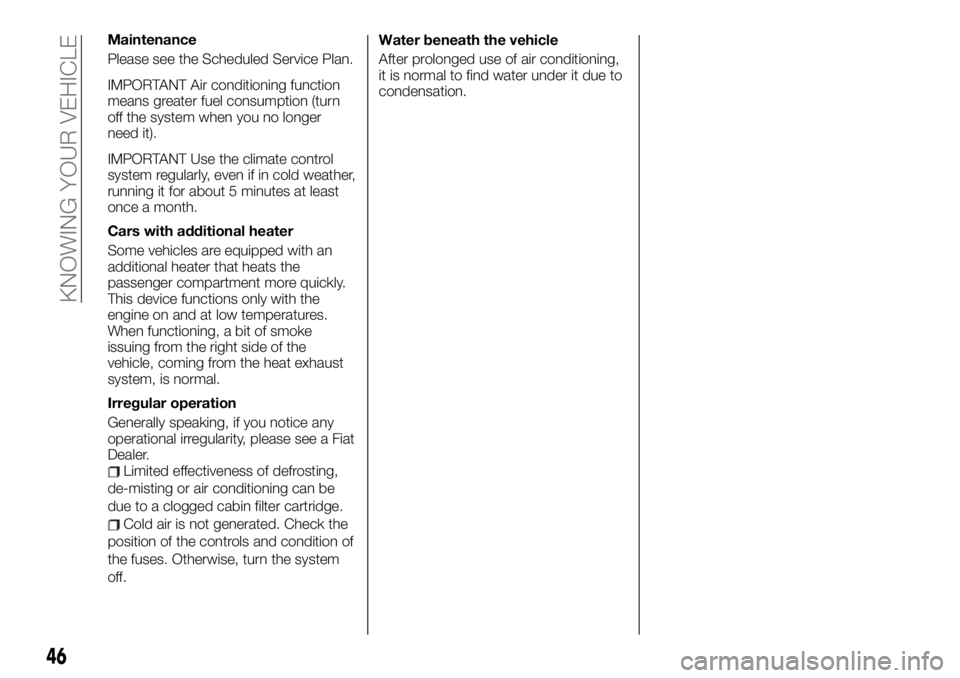
Maintenance
Please see the Scheduled Service Plan.
IMPORTANT Air conditioning function
means greater fuel consumption (turn
off the system when you no longer
need it).
IMPORTANT Use the climate control
system regularly, even if in cold weather,
running it for about 5 minutes at least
once a month.
Cars with additional heater
Some vehicles are equipped with an
additional heater that heats the
passenger compartment more quickly.
This device functions only with the
engine on and at low temperatures.
When functioning, a bit of smoke
issuing from the right side of the
vehicle, coming from the heat exhaust
system, is normal.
Irregular operation
Generally speaking, if you notice any
operational irregularity, please see a Fiat
Dealer.
Limited effectiveness of defrosting,
de-misting or air conditioning can be
due to a clogged cabin filter cartridge.
Cold air is not generated. Check the
position of the controls and condition of
the fuses. Otherwise, turn the system
off.Water beneath the vehicle
After prolonged use of air conditioning,
it is normal to find water under it due to
condensation.
46
KNOWING YOUR VEHICLE
Page 76 of 236
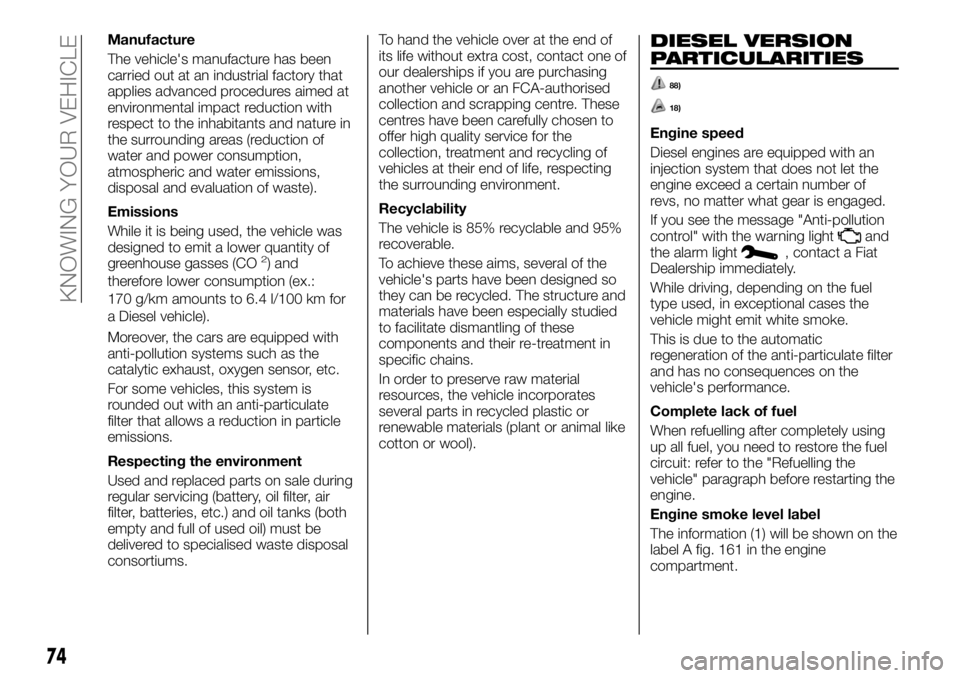
Manufacture
The vehicle's manufacture has been
carried out at an industrial factory that
applies advanced procedures aimed at
environmental impact reduction with
respect to the inhabitants and nature in
the surrounding areas (reduction of
water and power consumption,
atmospheric and water emissions,
disposal and evaluation of waste).
Emissions
While it is being used, the vehicle was
designed to emit a lower quantity of
greenhouse gasses (CO
2) and
therefore lower consumption (ex.:
170 g/km amounts to 6.4 l/100 km for
a Diesel vehicle).
Moreover, the cars are equipped with
anti-pollution systems such as the
catalytic exhaust, oxygen sensor, etc.
For some vehicles, this system is
rounded out with an anti-particulate
filter that allows a reduction in particle
emissions.
Respecting the environment
Used and replaced parts on sale during
regular servicing (battery, oil filter, air
filter, batteries, etc.) and oil tanks (both
empty and full of used oil) must be
delivered to specialised waste disposal
consortiums.To hand the vehicle over at the end of
its life without extra cost, contact one of
our dealerships if you are purchasing
another vehicle or an FCA-authorised
collection and scrapping centre. These
centres have been carefully chosen to
offer high quality service for the
collection, treatment and recycling of
vehicles at their end of life, respecting
the surrounding environment.
Recyclability
The vehicle is 85% recyclable and 95%
recoverable.
To achieve these aims, several of the
vehicle's parts have been designed so
they can be recycled. The structure and
materials have been especially studied
to facilitate dismantling of these
components and their re-treatment in
specific chains.
In order to preserve raw material
resources, the vehicle incorporates
several parts in recycled plastic or
renewable materials (plant or animal like
cotton or wool).
DIESEL VERSION
PARTICULARITIES
88)
18)
Engine speed
Diesel engines are equipped with an
injection system that does not let the
engine exceed a certain number of
revs, no matter what gear is engaged.
If you see the message "Anti-pollution
control" with the warning light
and
the alarm light, contact a Fiat
Dealership immediately.
While driving, depending on the fuel
type used, in exceptional cases the
vehicle might emit white smoke.
This is due to the automatic
regeneration of the anti-particulate filter
and has no consequences on the
vehicle's performance.
Complete lack of fuel
When refuelling after completely using
up all fuel, you need to restore the fuel
circuit: refer to the "Refuelling the
vehicle" paragraph before restarting the
engine.
Engine smoke level label
The information (1) will be shown on the
label A fig. 161 in the engine
compartment.
74
KNOWING YOUR VEHICLE
Page 167 of 236
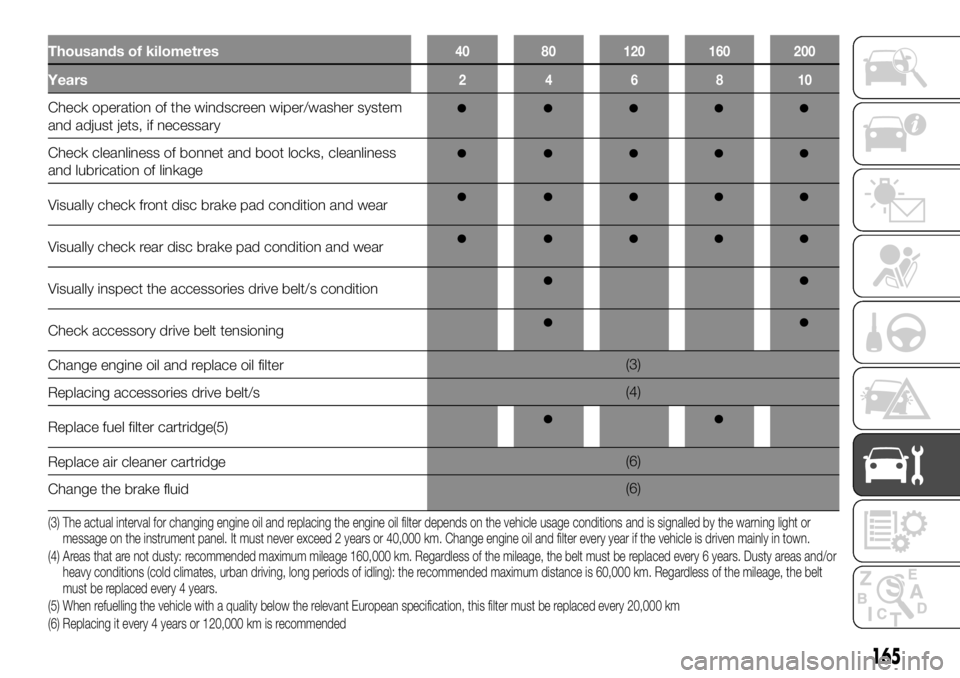
Thousands of kilometres40 80 120 160 200
Years246810
Check operation of the windscreen wiper/washer system
and adjust jets, if necessary
Check cleanliness of bonnet and boot locks, cleanliness
and lubrication of linkage
Visually check front disc brake pad condition and wear
Visually check rear disc brake pad condition and wear
Visually inspect the accessories drive belt/s condition
Check accessory drive belt tensioning
Change engine oil and replace oil filter(3)
Replacing accessories drive belt/s(4)
Replace fuel filter cartridge(5)
Replace air cleaner cartridge(6)
Change the brake fluid(6)
(3) The actual interval for changing engine oil and replacing the engine oil filter depends on the vehicle usage conditions and is signalled by the warning light or
message on the instrument panel. It must never exceed 2 years or 40,000 km. Change engine oil and filter every year if the vehicle is driven mainly in town.
(4) Areas that are not dusty: recommended maximum mileage 160,000 km. Regardless of the mileage, the belt must be replaced every 6 years. Dusty areas and/or
heavy conditions (cold climates, urban driving, long periods of idling): the recommended maximum distance is 60,000 km. Regardless of the mileage, the belt
must be replaced every 4 years.
(5) When refuelling the vehicle with a quality below the relevant European specification, this filter must be replaced every 20,000 km
(6) Replacing it every 4 years or 120,000 km is recommended
165
Page 170 of 236
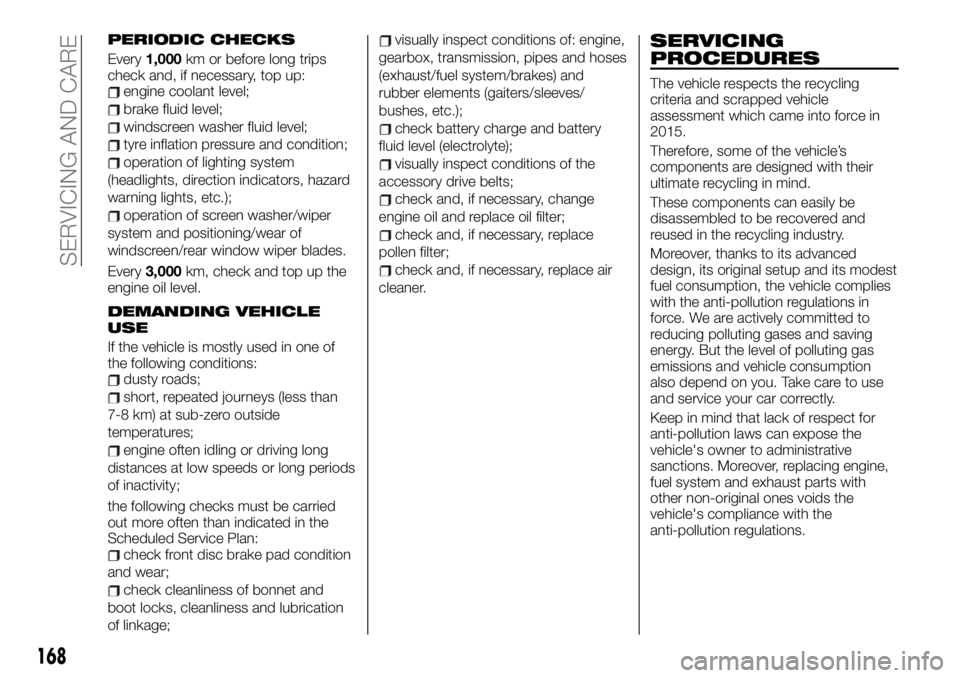
PERIODIC CHECKS
Every1,000km or before long trips
check and, if necessary, top up:
engine coolant level;
brake fluid level;
windscreen washer fluid level;
tyre inflation pressure and condition;
operation of lighting system
(headlights, direction indicators, hazard
warning lights, etc.);
operation of screen washer/wiper
system and positioning/wear of
windscreen/rear window wiper blades.
Every3,000km, check and top up the
engine oil level.
DEMANDING VEHICLE
USE
If the vehicle is mostly used in one of
the following conditions:
dusty roads;
short, repeated journeys (less than
7-8 km) at sub-zero outside
temperatures;
engine often idling or driving long
distances at low speeds or long periods
of inactivity;
the following checks must be carried
out more often than indicated in the
Scheduled Service Plan:
check front disc brake pad condition
and wear;
check cleanliness of bonnet and
boot locks, cleanliness and lubrication
of linkage;
visually inspect conditions of: engine,
gearbox, transmission, pipes and hoses
(exhaust/fuel system/brakes) and
rubber elements (gaiters/sleeves/
bushes, etc.);
check battery charge and battery
fluid level (electrolyte);
visually inspect conditions of the
accessory drive belts;
check and, if necessary, change
engine oil and replace oil filter;
check and, if necessary, replace
pollen filter;
check and, if necessary, replace air
cleaner.
SERVICING
PROCEDURES
The vehicle respects the recycling
criteria and scrapped vehicle
assessment which came into force in
2015.
Therefore, some of the vehicle’s
components are designed with their
ultimate recycling in mind.
These components can easily be
disassembled to be recovered and
reused in the recycling industry.
Moreover, thanks to its advanced
design, its original setup and its modest
fuel consumption, the vehicle complies
with the anti-pollution regulations in
force. We are actively committed to
reducing polluting gases and saving
energy. But the level of polluting gas
emissions and vehicle consumption
also depend on you. Take care to use
and service your car correctly.
Keep in mind that lack of respect for
anti-pollution laws can expose the
vehicle's owner to administrative
sanctions. Moreover, replacing engine,
fuel system and exhaust parts with
other non-original ones voids the
vehicle's compliance with the
anti-pollution regulations.
168
SERVICING AND CARE
Page 186 of 236
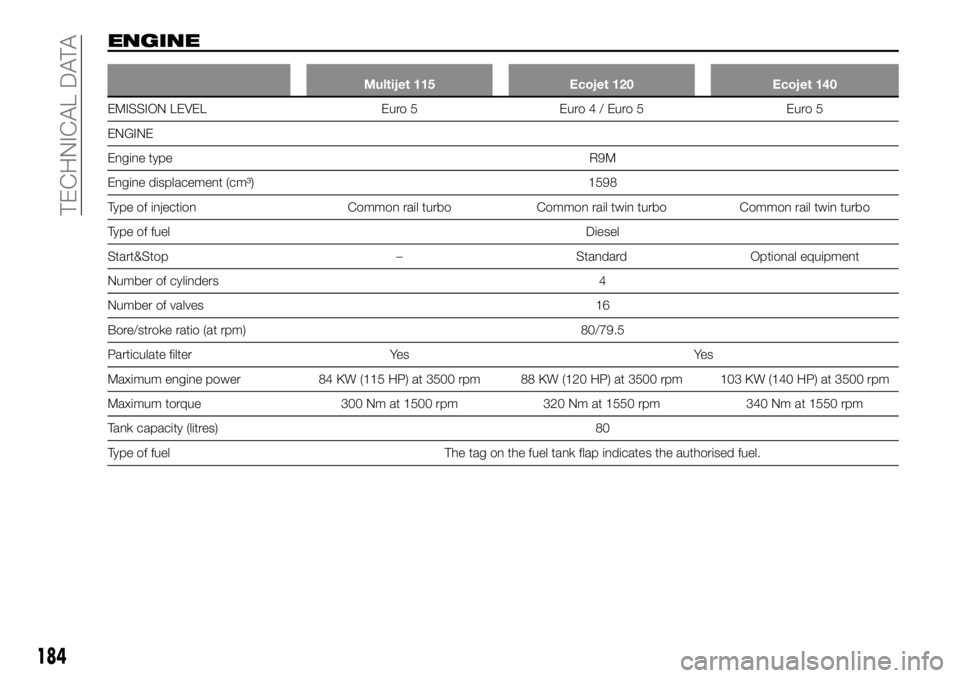
ENGINE
Multijet 115 Ecojet 120 Ecojet 140
EMISSION LEVEL Euro 5 Euro4/Eur
o5 Euro5
ENGINE
Engine typeR9M
Engine displacement (cm³) 1598
Type of injection Common rail turbo Common rail twin turbo Common rail twin turbo
Type of fuelDiesel
Start&Stop – Standard Optional equipment
Number of cylinders 4
Number of valves 16
Bore/stroke ratio (at rpm) 80/79.5
Particulate filter Yes Yes
Maximum engine power 84 KW (115 HP) at 3500 rpm 88 KW (120 HP) at 3500 rpm 103 KW (140 HP) at 3500 rpm
Maximum torque 300 Nm at 1500 rpm 320 Nm at 1550 rpm 340 Nm at 1550 rpm
Tank capacity (litres) 80
Type of fuel The tag on the fuel tank flap indicates the authorised fuel.
184
TECHNICAL DATA
Page 187 of 236
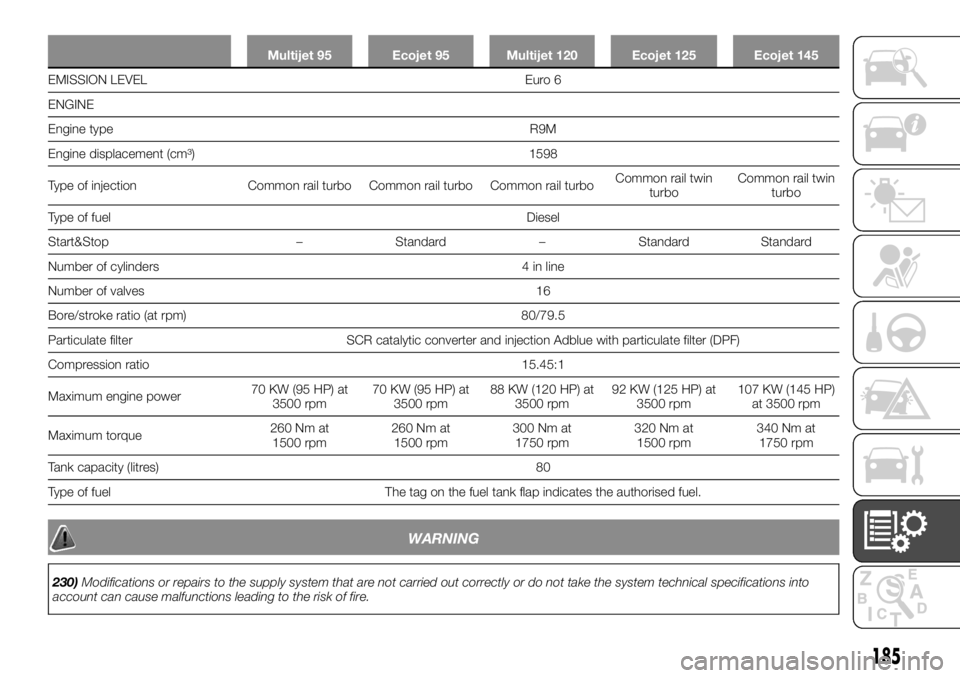
Multijet 95 Ecojet 95 Multijet 120 Ecojet 125 Ecojet 145
EMISSION LEVEL Euro 6
ENGINE
Engine
typeR9M
Engine displacement
(cm³) 1598
Type of injection Common rail turbo Common rail turbo Common rail turboCommon rail twin
turboCommon rail twin
turbo
Type of fuelDiesel
Start&Stop – Standard – Standard Standard
Number of cylinders 4 in line
Number of valves 16
Bore/stroke ratio (at rpm) 80/79.5
Particulate filter SCR catalytic converter and injection Adblue with particulate filter (DPF)
Compression ratio 15.45:1
Maximum engine power70 KW (95 HP) at
3500 rpm70 KW (95 HP) at
3500 rpm88 KW (120 HP) at
3500 rpm92 KW (125 HP) at
3500 rpm107 KW (145 HP)
at 3500 rpm
Maximum torque260 Nm at
1500 rpm260 Nm at
1500 rpm300 Nm at
1750 rpm320 Nm at
1500 rpm340 Nm at
1750 rpm
Tank capacity (litres) 80
Type of fuel The tag on the fuel tank flap indicates the authorised fuel.
WARNING
230)Modifications or repairs to the supply system that are not carried out correctly or do not take the system technical specifications into
account can cause malfunctions leading to the risk of fire.
185
Page 233 of 236
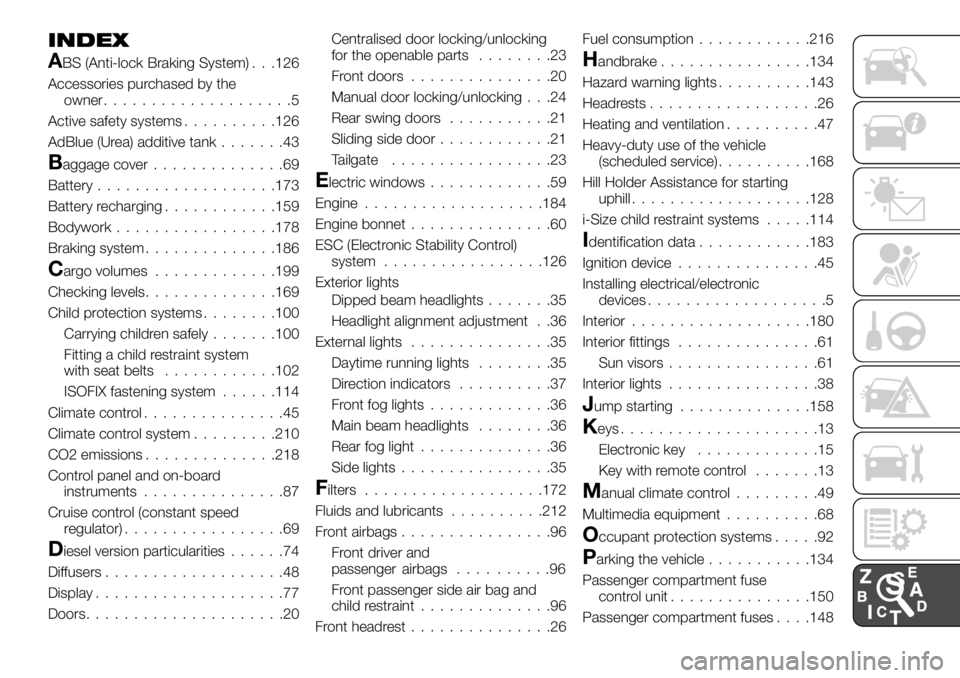
INDEX
ABS (Anti-lock Braking System) . . .126
Accessories purchased by the
owner....................5
Active safety systems..........126
AdBlue (Urea) additive tank.......43
Baggage cover..............69
Battery...................173
Battery recharging............159
Bodywork.................178
Braking system..............186
Cargo volumes.............199
Checking levels..............169
Child protection systems........100
Carrying children safely.......100
Fitting a child restraint system
with seat belts............102
ISOFIX fastening system......114
Climate control...............45
Climate control system.........210
CO2 emissions..............218
Control panel and on-board
instruments...............87
Cruise control (constant speed
regulator).................69
Diesel version particularities......74
Diffusers...................48
Display....................77
Doors.....................20Centralised door locking/unlocking
for the openable parts........23
Front doors...............20
Manual door locking/unlocking . . .24
Rear swing doors...........21
Sliding side door............21
Tailgate.................23
Electric windows.............59
Engine...................184
Engine bonnet...............60
ESC (Electronic Stability Control)
system.................126
Exterior lights
Dipped beam headlights.......35
Headlight alignment adjustment . .36
External lights...............35
Daytime running lights........35
Direction indicators..........37
Front fog lights.............36
Main beam headlights........36
Rear fog light..............36
Side lights................35
Filters...................172
Fluids and lubricants..........212
Front airbags................96
Front driver and
passenger airbags . . . . ......96
Front passenger side air bag and
child restraint..............96
Front headrest...............26Fuel consumption............216
Handbrake................134
Hazard warning lights..........143
Headrests..................26
Heating and ventilation..........47
Heavy-duty use of the vehicle
(scheduled service)..........168
Hill Holder Assistance for starting
uphill...................128
i-Size child restraint systems.....114
Identification data............183
Ignition device...............45
Installing electrical/electronic
devices...................5
Interior...................180
Interior fittings...............61
Sun visors................61
Interior lights................38
Jump starting..............158
Keys.....................13
Electronic key.............15
Key with remote control.......13
Manual climate control.........49
Multimedia equipment..........68
Occupant protection systems.....92
Parking the vehicle...........134
Passenger compartment fuse
control unit...............150
Passenger compartment fuses. . . .148